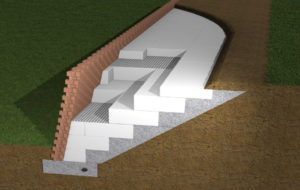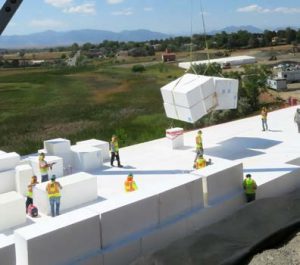Keep your retaining walls stable with Insulfoam Geofoam
From rebuilding a collapsed highway in Colorado to supporting the expansion of a bridge in Idaho, Insulfoam expanded polystyrene (EPS) Geofoam offers a sturdy foundation when structural fill is needed.
Insulfoam produces several types of structural EPS Geofoam and infill. The rigid foam blocks are available in nearly any size as well as in seven different densities from Insulfoam factories across the country. The range of sizes, ability to customize the blocks to nearly any shape and load-bearing capabilities make EPS Geofoam an ideal solution for engineers and architects that are designing a retaining wall.
Geofoam fills in for other materials
EPS Geofoam offers a number of benefits over using fill soil or trucking in heavy rocks to the hard-to-reach spaces where retaining walls are often found. The lightweight nature of EPS Geofoam can reduce or eliminate the need for heavy earth moving and compaction equipment because blocks can be easily picked up and placed manually. Additionally, at sites with rough terrains or poor access, EPS Geofoam blocks can be transported, handled and placed faster than soil and other fills.
A defining feature of EPS Geofoam is that it is ultra-lightweight compared to other fills. Geofoam is available in densities ranging from approximately 0.7 to 2.85 pounds per cubic foot. Other fill materials such as soil (99 to 116 pounds per cubic foot), cellular concrete (24 to 90 pounds per cubic foot) or wood chips (15 to 30 pounds per cubic foot) are significantly denser than InsulFoam GF46, which is 2.85 pounds per cubic foot.
EPS Geofoam also offers high compressive strength. This makes the geo-synthetic fill durable and resistant to damage over time. The material’s compressive resistance ranges from about 317 to 2,678 pounds per square foot at a 1% strain. As long as combined dead/live loads are not in excess of 1% strain, the material will not creep or experience plastic yield.
 Finding common ground
Finding common ground
Insulfoam EPS Geofoam is manufactured with consistent properties throughout each individual block that gives it an additional advantage over other infill materials: uniformity. Other lightweight fill materials (such as wood chips and fibers) can be varied and inconsistent in their make-up. Such inconsistencies can result in non-uniform load transfer and differential settlement. This type of settlement can cause dangerous, uneven structure settling and lead to further damage.
On the other hand, EPS Geofoam uniquely disburses or spreads the load out across a wide area, minimizing post-construction settling and creating a more stable retaining wall. Point blank—the application of EPS Geofoam significantly reduces the lateral load caused by the wedge of soil.
Additional Geofoam benefits
Insulfoam Geofoam is also easy to design around. The blocks are manufactured to meet job specific requirements, including sizing and density requirements. And if there’s a need to customize a block around an immovable obstacle such as a utility line, Insulfoam Geofoam can easily be cut on-site with hot wire tooling or saws.
In addition to the structural stability and predictability it offers, EPS Geofoam is a chemically stable, inert product that won’t decompose, decay or produce undesirable gasses or leachates. This makes it an ideal material for designing a long-term retaining wall. But if a need ever arises to remove it, Insulfoam Geofoam is recyclable and safe for waste-to-energy (WTE) systems and landfills should it ever need to be repurposed.
For a project where long-term stability is crucial, EPS Geofoam is an ideal solution. If you’re ready to learn how Insulfoam can partner with your team on your next retaining wall project, contact us today.

